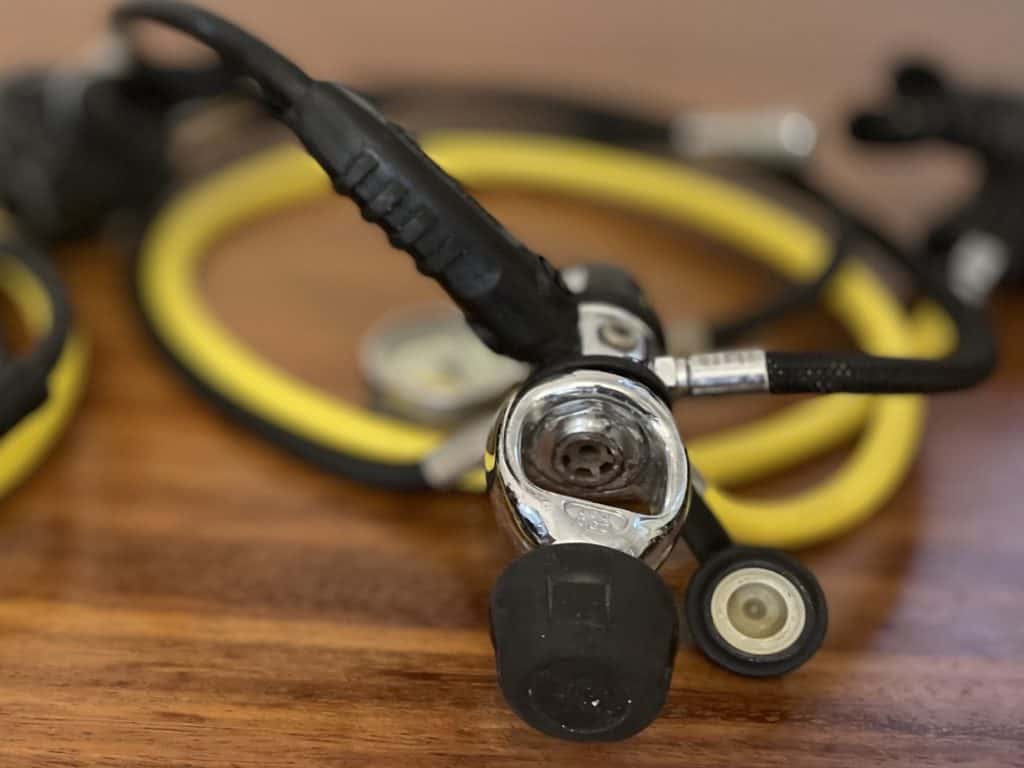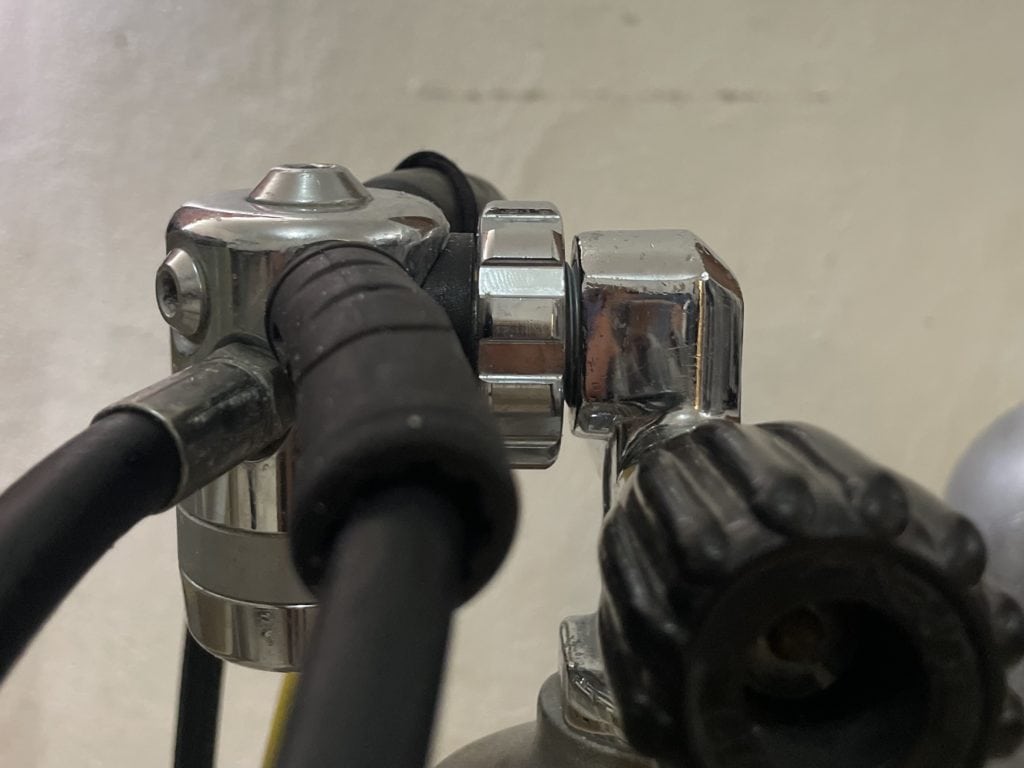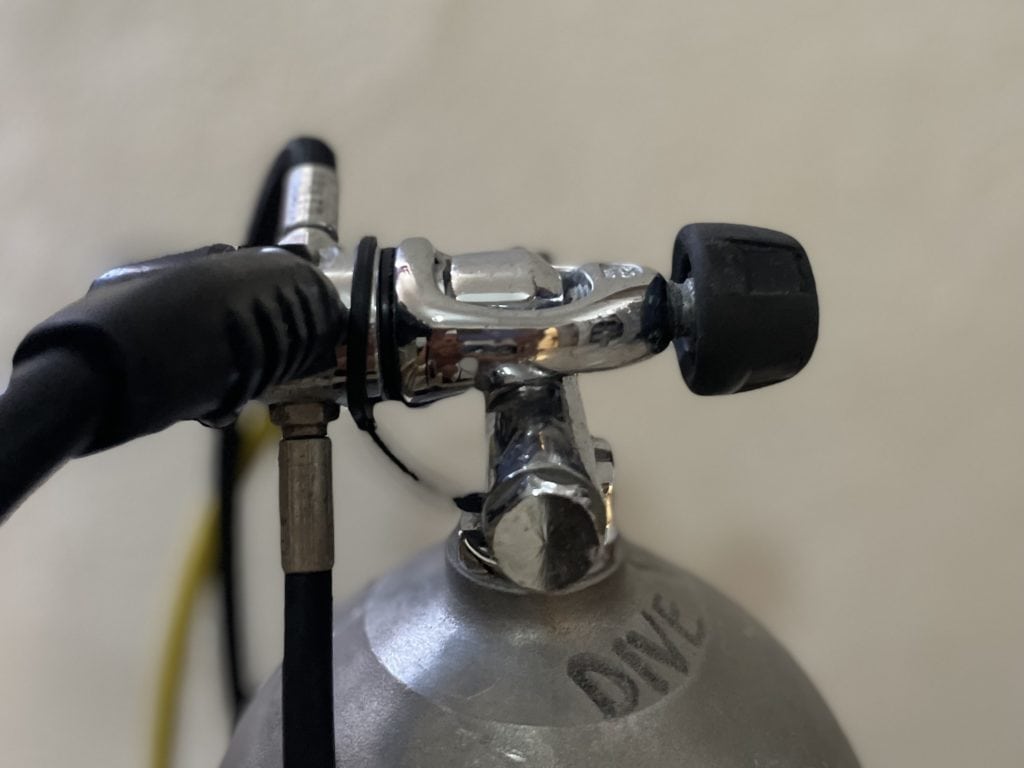A question many new divers become confronted with upon shopping for their first scuba diving equipment is, what first stage regulator they should buy: DIN vs. Yoke?
During our first diving course, we mostly rented all equipment and didn’t put a lot of thought into brands, and tec-specs and maybe we were not taught about diving regulators in detail. Often times divers, realizing that there are different regulators, are already overwhelmed in deciding what model might be best for them.
In this blog, we explain to you the difference between DIN vs. yoke scuba regulators, where they’re used and what you should consider when deciding whether to buy one or the other!
What Are The 2 Types of SCUBA Regulators?
When learning about SCUBA diving regulators, it is important to notice that there are many components to a functional and ready-to-go scuba diving regulator.
The part attaching to the mouthpiece that the diver breathes from is called the “second stage” of a scuba regulator. In recreational diving, we typically have two of those, a main second stage, and an emergency second stage (the octopus). A diving regulator’s second stage can have a lot of different features too, but that’s for sure a whole topic for another blog.
The “first stage” of a scuba diving regulator is the part, the two second stages, the inflator hose, and your SPG are attached to, also it’s the part that eventually connects to the tank.
This important piece of a scuba diving regulator is what we’re talking about today. It comes with one of two different connection types: DIN or Yoke.

What’s The Difference Between A DIN vs. Yoke Regulator?
After knowing that there are two different scuba regulators and tank valves, divers’ follow-up question is almost always: “What is the difference between DIN and yoke?”
DIN First Stage Connection
The key feature of a DIN first stage regulator is its connection to the tank, which consists of a threaded male connector eventually screwing into a female-type tank valve.
This connection uses a sealing o-ring in the male connector of the DIN first stage rather than on the tank valve.

What Does “DIN” Valve Stand For?
DIN is an acronym for “Deutsche Institut für Normung” (German Institute for Standardization). It is a Berlin-located industrial testing and approving agency that standardizes a constantly increasing range of products in mechanics, technology, and engineering.
But don’t be mistaken, the originally in the US created valve connection was first launched by American diving equipment manufacturer Poseidon in the late 1950s, but it didn’t get much attention and acceptance by divers back then.
Years later DIN decided their standard tank pressure valves for industry including commercial diving to be the ⅝ -inch male/female threaded type connection, the one originally designed by Poseidon.
The valve and regulator connection therefore inherited the names DIN valve and DIN first stage regulator.

YOKE First Stage Connection
While the DIN connection screws into a female-type valve, a Yoke first stage connection rather fits over a tank-valve outlet and gets fixed into place with a screw pointing to the back of the tank-valve outlet. You will not find a visible o-ring on the yoke first stage connection, but a functional yoke tank valve has a visible o-ring, that the regulator clamp fits over seamlessly.
Yoke connections exist as long as scuba diving does, and were the preferred and mostly used connections in the early evolution of scuba equipment. Therefore you’ll mostly find yoke valves on rental scuba tanks during vacation at many destinations.
Nowadays there are many fancy gadgets, designs, and extra functions for SCUBA regulators. Still, when it comes down to tank connections, we can confidently say there are only two different ones. DIN or yoke(INT) connections.

Can You Use A DIN Regulator on A Yoke Tank Valve or Vice Versa?
This is a rather tricky question that you can answer with both, yes and no. You can technically use a DIN first stage regulator on a yoke tank valve, but you need an adapter for it.
So finding yourself on a diving boat with a DIN regulator and only yoke tanks available would turn out rather unfavorable if no one has an adapter for you.
The same applies to the scenario vice versa – if you have a first stage regulator with a yoke connection to be used with a DIN tank valve, you will need a so-called donut adaptor to be screwed into the DIN valve. This will make it suitable for the yoke connection, but without the adapter, you won’t be able to dive.

Many dive operators and boats carry adapters for any occasion on their dive days. Others provide different tanks to suit both types of regulators, but it’s always a good call to ensure you have your own – just in case.
What’s Better, DIN or Yoke?
Yoke first stage regulators and tank valves have a long history in scuba diving and are commonly used worldwide still today.
DIN regulators and valves can be built and approved to a working pressure of 300 bar, while on the contrary, a yoke regulator’s maximum working pressure is commonly 232 bar. Therefore the DIN system is the preferred one for industrial use like commercial diving.
It’s important to understand, that there are two different designs to DIN regulator connections that might look similar. The more commonly used so-called “200bar DIN valve” and the “300bar DIN valve”, with the least being a good bit deeper to screw into, so the shorter “200bar” connector o-ring won’t seal with the tank.
This serves as a safety feature to prevent divers from using a lower-pressure regulator with a 300+ bar pressurized tank. Always check and know the exact working pressure rating for your scuba diving regulator to avoid accidents and failures.
Safety Advantages of A DIN Regulator/Tank System
There certainly are some marginal safety advantages technical divers have found important enough to benefit from.
Not only does a greater pressure capacity lead to more possible dive time and profiles, but it also makes tank-refilling safer as a rupture is less likely, thanks to the two connections screwed into each other rather than clamped.

Going further into technical diving, cave, and wreck divers found another valid safety advantage to be taken into account while choosing the right regulator for your dives.
The bulky setup of the yoke connection risks entanglement is less streamlined, and tests have resulted in the yoke regulator system being less resilient to direct impact. A Yoke first stage regulator could even be knocked off the tank under extreme circumstances.
The exposed o-ring on the tank valve with yoke attachment can be damaged during transportation too, which is rather unlikely for an o-ring on a din-regulator protected by a dust cap during transportation.
For side mount diving, DIN is the way to go whether diving in a recreational or a technical side mount configuration. As the tank valve gets mounted directly under the diver’s armpit, a yoke regulator would be very uncomfortably sticking towards your body while diving.
Do The U.S. and Mexico Use DIN or Yoke?
In the U.S., Mexico, most of the Caribbean, and Southeast Asia we predominantly find so-called K-valves on tanks with yoke attachment points, so yoke regulators are commonly used.

Some other places like Europe have opted for using DIN tank valves in their daily operations, be it recreational, technical, or commercial diving. But as well in the United States and Mexico, more and more recreational divers choose a DIN regulator for their personal scuba equipment.
So depending on where you live and especially important where you dive, you might want to choose a different regulator to buy. In the end, it all comes down to your personal preferences, types of dives, frequency of dives, and availability at your location, and most modern models have both options available, DIN or Yoke, to choose from upon ordering.
DIN vs. Yoke: What Does DivePoint Provide?
Here in Playa del Carmen, we provide both types of tanks and rental regulators, DivePoint owns DIN tanks, offers yoke adaptors if necessary, or provides yoke tank valves if desired.
Our rental regulators can be both, we count with DIN regulators as well as yoke regulators. For Cenote dives we mostly offer DIN regulators for rental, as we use our own tanks for those tours. Boats usually have yoke tanks, which is why we generally provide yoke regulators for courses.
We hope you enjoyed reading this blog post about “DIN vs. Yoke”!
Contact us if you have any questions about SCUBA diving equipment or want to go diving – We’re happy to help!
Stay up to date reading our other interesting blog topics & follow us on our Facebook and Instagram pages.


